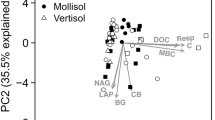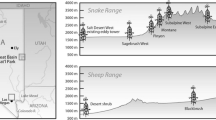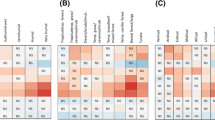Abstract
Soil is a prominent component of terrestrial C and N budgets. Soil C and N pools are influenced by, and may reciprocally influence, many environmental factors. Our objective was to determine the quantitative relations of surface mineral-soil organic C, N, and C/N ratios to climate and soil texture across seven ecological regions that make up the conterminous USA. Up to 608 soil profiles per region and their corresponding climates were evaluated with regression analysis. The organic C pool (kg C m−2) in the upper 20 cm of mineral soil was positively related to mean annual precipitation, evapotranspiration and clay content in all regions. It was negatively related to a temperature/precipitation index in all regions and negatively related to mean annual temperature, except in the northwest temperate forest region. Soil C/N ratios were negatively related to clay or silt content in all regions. These relations are consistent with concepts of moisture and temperature controls on detrital production, differential effects of temperature on detrital production and decomposition, and stabilization of organic matter by clay and silt. Differences in quantitative relations among regions may be related to vegetation-composition effects on soil organic matter processes, clay mineralogy, and faunal mixing of surface organic horizons with mineral soil. Regional differences also occurred in the importance of climate vs. soil texture in explaining the variability in soil C. The regional differences indicate the importance of using region-specific, rather than generalized, equations for projecting long-term soil responses to climate change and for conducting ecosystem-model calibration or validation.





Similar content being viewed by others
Abbreviations
- AET:
-
Actual evapotranspiration
- MAP:
-
Mean annual precipitation
- MAT:
-
Mean annual temperature
- SOC:
-
Mineral-soil organic carbon
- USA:
-
United States of America
References
Amelung W, Flach KW, Zech W (1997) Climatic effects on soil organic matter composition in the Great Plains. Soil Sci Soc Am J 61:115–123
Amelung W, Zech W, Zhang X, Follett RF, Tiessen H, Knox E, Flach K-W (1998) Carbon, nitrogen, and sulfur pools in particle-size fractions as influenced by climate. Soil Sci Soc Am J 62:172–181
Batjes NH (1996) Total carbon and nitrogen in the soils of the world. European J Soil Sci 47:151–163
Birkland PW (1999) Soils and geomorphology, 3rd edn. Oxford University Press, New York
Burke IC, Yonker CM, Parton WJ, Cole CV, Flach K, Schimel DS (1989) Texture, climate, and cultivation effects on soil organic matter content in U.S. grassland soils. Soil Sci Soc Am J 53:800–805
Callesen I, Liski J, Raulund-Rasmussen K, Olsson MT, Tau-Strand L, Vesterdal L, Westman CJ (2003) Soil carbon stores in Nordic well-drained forest soils—relationships with climate and texture class. Global Change Biol 9:358–370
Cole DW, Compton JE, Homann PS, Edmonds RL, Van Miegroet H (1995) Comparison of carbon accumulation in Douglas fir and red alder forests. In: McFee WW, Kelly JM (eds) Carbon forms and functions in forest soils. Soil Science Society of America, Madison, WI
Conant RT, Klopatek JM, Malin RC, Klopatek CC (1998) Carbon pools and fluxes along an environmental gradient in northern Arizona. Biogeochemistry 43:43–61
Dai W, Huang Y (2006) Relation of soil organic matter concentration to climate and altitude in zonal soils of China. Catena 65:87–94
Daly C, Neilson RP, Phillips DL (1994) A statistical-topographic model for mapping climatological precipitation over mountainous terrain. J Appl Meteor 33:140–158
De Vries W, Reinds GJ, Gundersen P, Sterba H (2006) The impact of nitrogen deposition on carbon sequestration in European forests and forest soils. Global Change Biol 12:1151–1173
Douglas CL Jr, Rasmussen PE, Collins HP, Albrecht SL (1998) Nitrogen mineralization across a climosequence in the Pacific Northwest. Soil Biol Biochem 30:1765–1772
Eisenhauer N, Partsch S, Parkinson D, Scheu S (2007) Invasion of a deciduous forest by earthworms: Changes in soil chemistry, microflora, microarthropods and vegetation. Soil Biol Biochem 39:1099–1110
Evans CD, Caporn SJM, Carroll JA, Pilkington MG, Wilson DB, Ray N, Cresswell N (2006) Modelling nitrogen saturation and carbon accumulation in heathland soils under elevated nitrogen deposition. Environ Pollut 143:468–478
Franzluebbers AJ, Haney RL, Honeycutt CW, Arshad MA, Schomberg HH, Hons FM (2001) Climatic influences on active fractions of soil organic matter. Soil Biol Biochem 33:1103–1111
Franzmeier DP, Lemme GD, Miles RJ (1985) Organic carbon in soils of north central United States. Soil Sci Soc Am J 49:702–708
Ganuza A, Almendros G (2003) Organic carbon storage in soils of the Basque Country (Spain): the effect of climate, vegetation type and edaphic variables. Biol Fertil Soils 37:154–162
Grigal DF, Ohmann LF (1992) Carbon storage in upland forests of the Lake States. Soil Sci Soc Am J 56:935–943
Guo Y, Gong P, Amundson R, Yu Q (2006) Analysis of factors controlling soil carbon in the conterminous United States. Soil Sci Soc Am J 70:601–612
Hassink J, Bouwman LA, Zwart KB, Bloem J, Brussaard L (1993) Relationships between soil texture, physical protection of organic matter, soil biota, and C and N mineralization in grassland soils. Geoderma 57:105–128
Homann PS, Caldwell BA, Chappell HN, Sollins P, Swanston CW (2001) Douglas-fir soil C and N properties a decade after termination of urea fertilization. Can J Forest Res 31:2225–2236
Homann PS, Grigal DF (1996) Below-ground organic carbon and decomposition potential in a field-forest glacial-outwash landscape. Biol Fertil Soils 23:207–214
Homann PS, McKane RB, Sollins P (2000) Belowground processes in forest-ecosystem biogeochemical simulation models. Forest Ecol Manage 138:3–18
Homann PS, Remillard SM, Harmon ME, Bormann BT (2004) Carbon storage in coarse and fine fractions of Pacific Northwest old-growth forest soils. Soil Sci Soc Am J 68:2023–2030
Homann PS, Sollins P, Chappell HN, Stangenberger AG (1995) Soil organic carbon in a mountainous, forested region: relation to site characteristics. Soil Sci Soc Am J 59:1468–1475
Honeycutt CW, Heil RD, Cole CV (1990) Climatic and topographic relations of three Great Plains soils. II. Carbon, nitrogen, and phosphorus. Soil Sci Soc Am J 54:476–483
Hontoria C, Rodríguez-Murillo JC, Saa A (1999) Relationships between soil organic carbon and site characteristics in peninsular Spain. Soil Sci Soc Am J 63:614–621
Jenny H (1941) Factors of soil formation. McGraw Hill, New York
Jenny H (1980) The soil resource. Springer-Verlag, New York
Jobbágy EG, Jackson RB (2000) The vertical distribution of soil organic carbon and its relation to climate and vegetation. Ecol Applic 10:423–436
Johnson DW, Lindberg SE (eds) (1992) Atmospheric deposition and forest nutrient cycling. Springer-Verlag, New York
Johnson MG, Kern JS (2003) Quantifying the organic carbon held in forested soils of the United States and Puerto Rico. In: Kimble JM, Heath LS, Birdsey RA, Lal R (eds) The potential of U.S. forest soils to sequester carbon and mitigate the greenhouse effect. CRC Press, New York
Kane ES, Valentine DW, Schuur EAG, Dutta K (2005) Soil carbon stabilization along climate and stand productivity gradients in black spruce forests of interior Alaska. Can J Forest Res 35:2118–2129
Kirschbaum MUF (2000) Will changes in soil organic carbon act as a positive or negative feedback on global warming? Biogeochemistry 48:21–51
Kittel TGF, Rosenbloom NA, Royle JA, Daly C, Gibson WP, Fisher HH, Thornton P, Yates DN, Aulenbach S, Kaufman C, McKeown R, Bachelet D, Schimel DS (2004) VEMAP phase 2 bioclimatic database. I. Gridded historical (20th century) climate for modeling ecosystem dynamics across the conterminous USA. Climate Res 27:151–170
Kulmatiski A, Vogt DJ, Siccama TG, Tilley JP, Kolesinskas K, Wickwire TW, Larson BC (2004) Landscape determinants of soil carbon and nitrogen storage in southern New England. Soil Sci Soc Am J 68:2014–2022
Liski J, Westman CJ (1997) Carbon storage in forest soil of Finland. 1. Effect of thermoclimate. Biogeochemistry 36:239–260
Manrique LA, Jones CA (1991) Bulk density of soils in relation to soil physical and chemical properties. Soil Sci Soc Am J 55:476–481
Miller AJ, Amundson R, Burke IC, Yonker C (2004) The effect of climate and cultivation on soil organic C and N. Biogeochemistry 67:57–72
Nichols JD (1984) Relation of organic carbon to soil properties and climate in the southern Great Plains. Soil Sci Soc Am J 48:1382–1384
Parton WJ, Schimel DS, Cole CV, Ojima DS (1987) Analysis of factors controlling soil organic matter levels in Great Plains grasslands. Soil Sci Soc Am J 51:1173–1179
Paruelo JM, Jobbágy EG, Sala OE, Lauenroth WK, Burke IC (1998) Functional and structural convergence of temperate grassland and shrubland ecosystems. Ecol Applic 8:194–206
Pepper DA, Del Grosso SJ, McMurtrie RE, Parton WJ (2005) Simulated carbon sink response of shortgrass steppe, tallgrass prairie and forest ecosystems to rising [CO2], temperature and nitrogen input. Global Biogeochem Cycles 19:GB1004, DOI 10.1029/2004GB002226
Percival HJ, Parfitt RL, Scott NA (2000) Factors controlling soil carbon levels in New Zealand grasslands: is clay content important? Soil Sci Soc Am J 64:1623–1630
Perruchoud D, Walthert L, Zimmermann S, Lüscher P (2000) Contemporary carbon stocks of mineral forest soils in the Swiss Alps. Biogeochemistry 50:111–136
Plante AF, Conant RT, Stewart CE, Pautian K, Six J (2006) Impact of soil texture on the distribution of soil organic matter in physical and chemical fractions. Soil Sci Soc Am J 70:287–296
Post WM, Emmanuel WR, Zinke PJ, Stangenberger AG (1982) Soil carbon pools and world life zones. Nature 298:156–159
Post WM, Pastor J, Zinke PJ, Stangenberger AG (1985) Global patterns of soil nitrogen storage. Nature 317:613–616
Reich PB, Oleksyn J, Modrzynski J, Mrozinski P, Hobbie SE, Eissenstat DM, Chorover J, Chadwick OA, Hale CM, Tjoelker MG (2005) Linking litter calcium, earthworms and soil properties: a common garden test with 14 tree species. Ecol Lett 8:811–818
Richter DD, Markewitz D, Trumbore SE, Wells CG (1999) Rapid accumulation and turnover of soil carbon in a re-establishing forest. Nature 400:56–58
Rothe A, Cromack K Jr, Resh SC, Makineci E, Son Y (2002) Soil carbon and nitrogen changes under Douglas-fir with and without red alder. Soil Sci Soc Am J 66:1988–1995
Schlesinger WH (1997) Biogeochemistry, an analysis of global change, 2nd edn. Academic Press, New York
Sims ZR, Nielsen GA (1986) Organic carbon in Montana soils as related to clay content and climate. Soil Sci Soc Am J 50:1269–1271
Smith SJ, Thomson AM, Rosenberg NJ, Izaurralde RC, Brown RA, Wigley TML (2005) Climate change impacts for the conterminous USA: an integrated assessment. Part 1. Scenarios and context. Climatic Change 69:7–25
Soil Survey Laboratory Staff (1992) Soil survey laboratory methods manual. Soil survey investigations report no. 42, version 2.0. National Soil Survey Center, Lincoln, NB, USA
Sollins P, Homann PS, Caldwell B (1996) Stabilization and destabilization of soil organic matter: mechanisms and controls. Geoderma 74:65–105
Somaratne S, Seneviratne G, Coomaraswamy U (2005) Prediction of soil organic carbon across different land-use patterns: a neural network approach. Soil Sci Soc Am J 69:1580–1589
Sorensen LH (1981) Carbon-nitrogen relationships during the humification of cellulose in soils containing different amounts of clay. Soil Biol Biochem 13:313–321
Spain AV (1990) Influence of environmental conditions and some soil chemical properties on the carbon and nitrogen contents of some tropical Australian rainforest soils. Aust J Soil Res 28:825–839
Sun OJ, Campbell J, Law BE, Wolf V (2004) Dynamics of carbon stocks in soils and detritus across chronosequences of different forest types in the Pacific Northwest, USA. Global Change Biol 10:1470–1481
Swanston C, Homann PS, Caldwell BA, Myrold DD, Ganio L, Sollins P (2004) Long-term effects of elevated nitrogen on forest soil organic matter stability. Biogeochemistry 70:227–250
VEMAP Members (1995) Vegetation/ecosystem modeling and analysis project: comparing biogeography and biogeochemistry models in a continental-scale study of terrestrial ecosystem responses to climate change and CO2 doubling. Global Biogeochem Cycles 9:407–437
Xie XL, Sun B, Zhou HZ, Li AB (2004) Soil organic carbon storage in China. Pedosphere 14:491–500
Zar JH (1999) Biostatistical analysis, 4th edn. Prentice Hall, Upper Saddle River, NJ, USA
Acknowledgements
We thank John Kimble for his continued efforts to make funds and soil data available for environmental research. We thank Chris Daly and the Oregon Climate Service for access to PRISM climate layers. Major funding was provided by the Natural Resources Conservation Service, under NRCS agreement number 68-7482-7-310. Additional funding was provided by the Office of Research and Sponsored Programs, Western Washington University. We thank three anonymous reviewers for helpful comments on an earlier version of this manuscript.
Author information
Authors and Affiliations
Corresponding author
Rights and permissions
About this article
Cite this article
Homann, P.S., Kapchinske, J.S. & Boyce, A. Relations of mineral-soil C and N to climate and texture: regional differences within the conterminous USA. Biogeochemistry 85, 303–316 (2007). https://doi.org/10.1007/s10533-007-9139-6
Received:
Accepted:
Published:
Issue Date:
DOI: https://doi.org/10.1007/s10533-007-9139-6




